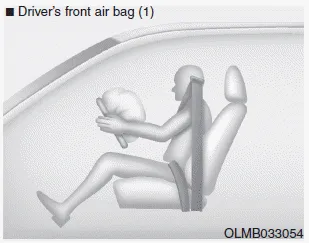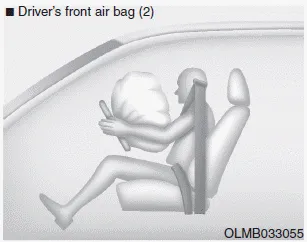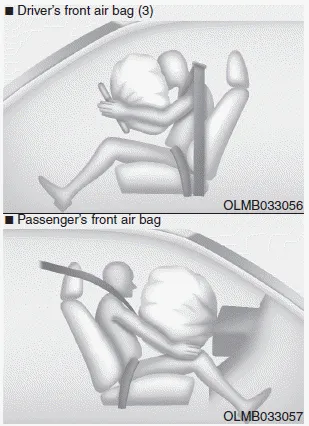Hyundai i30 (PD): Air bag - supplemental restraint system / How does the air bags system operate?

The SRS consists of the following components:
(1) Driver's front air bag module/
Driver’s knee air bag module
(2) Passenger's front air bag module
(3) Side air bag modules/
Side impact sensors
(4) Curtain air bag modules
(5) Rear Retractor pre-tensioner
(6) Retractor pre-tensioner assemblies
(7) Air bag warning light
(8) SRS control module (SRSCM)/
Rollover sensor
(9) Front impact sensors
(10) Side pressure sensors
(11) Passenger’s front air bag
ON/OFF indicator
(12) Passenger’s front air bag
ON/OFF switch
The SRSCM continually monitors all SRS components whilst the ignition switch is ON to determine if a crash impact is severe enough to require air bag deployment or pre-tensioner seat belt deployment.
SRS warning light

The SRS (Supplement Restraint System) air bag warning light on the instrument panel displays the air bag symbol depicted in the illustration.The system checks the air bag electrical system for malfunctions. The light indicates that there is a potential problem with your air bag system, which could include your side and/or curtain air bags used for rollover protection (if equipped with rollover sensor).
WARNING
If your SRS malfunctions, the air bag may not inflate properly during an accident increasing the risk of serious injury or death.
If any of the following conditions occur, your SRS is malfunctioning:
- The light does not turn on for approximately six seconds when the ignition switch is in the ON position.
- The light stays on after illuminating for approximately six seconds.
- The light comes on whilst the vehicle is in motion.
- The light blinks when the engine is running.
We recommend that a HYUNDAI authorised repairer inspect the SRS as soon as possible if any of these conditions occur.
During a moderate to severe frontal collision, sensors will detect the vehicle’s rapid deceleration. If the rate of deceleration is high enough, the control unit will inflate the front air bags, at the time and with the force needed.
The front air bags help protect the driver and front passenger by responding to frontal impacts in which seat belts alone cannot provide adequate restraint. When needed, the side air bags help provide protection in the event of a side impact or rollover by supporting the side upper body area.
- Air bags are activated (able to inflate if necessary) only when the ignition switch is in the ON position.
- Air bags inflate in the event of certain frontal or side collisions to help protect the occupants from serious physical injury.
- There is no single speed at which the air bags will inflate. Generally, air bags are designed to inflate based upon the severity of a collision and its direction. These two factors determine whether the sensors produce an electronic deployment/ inflation signal.
- Air bag deployment depends on a number of factors including vehicle speed, angles of impact and the density and stiffness of the vehicles or objects which your vehicle impacts during a collision. The determining factors are not limited to those mentioned above.
- The front air bags will completely inflate and deflate in an instant. It is virtually impossible for you to see the air bags inflate during an accident. It is much more likely that you will simply see the deflated air bags hanging out of their storage compartments after the collision.
- In addition to inflating in serious side collisions, vehicles equipped with a rollover sensor, side and/or curtain air bags will inflate if the sensing system detects a rollover. When a rollover is detected, curtain air bags will remain inflated longer to help provide protection from ejection, especially when used in conjunction with the seat belts. (if equipped with a rollover sensor)
- To help provide protection, the air bags must inflate rapidly. The speed of air bag inflation is a consequence of extremely short time in which to inflate the air bag between the occupant and the vehicle structures before the occupant impacts those structures. This speed of inflation reduces the risk of serious or lifethreatening injuries and is thus a necessary part of air bag design. However, the rapid air bag inflation can also cause injuries which can include facial abrasions, bruises and broken bones because the inflation speed also causes the air bags to expand with a great deal of force.
- There are even circumstances under which contact with the air bag can cause fatal injuries, especially if the occupant is positioned excessively close to the air bag.
You can take steps to reduce the risk of being injured by an inflating air bag. The greatest risk is sitting too close to the air bag. An air bag needs space to inflate. It is recommended that drivers sit as far as possible between the centre of the steering wheel and the chest whilst still maintaining control of the vehicle.

When the SRSCM detects a sufficiently severe impact to the front of the vehicle, it will automatically deploy the front air bags.

Upon deployment, tear seams molded directly into the pad covers will separate under pressure from the expansion of the air bags. Further opening of the covers allows full inflation of the air bags.
A fully inflated air bag, in combination with a properly worn seat belt, slows the driver's or the front passenger's forward motion, reducing the risk of head and chest injury.

After complete inflation, the air bag immediately starts deflating, enabling the driver to maintain forward visibility and the ability to steer or operate other controls.
WARNING
To prevent objects from becoming dangerous projectiles when the passenger's air bag inflates:
- Do not install or place any objects (drink holder, CD holder, stickers, etc.) on the front passenger's panel above the glove box where the passenger's air bag is located.
- Do not install a container of liquid air freshener near the instrument cluster or on the instrument panel surface.
Curtain air bags are located along both sides of the roof rails above the front and rear doors. They are designed to help protect the heads of the front seat occupants and the rear outboard seat occupants in certain side impact collisions.
After a frontal or side air bag inflates, it will deflate very quickly. Air bag inflation will not prevent the driver from seeing out of the windscreen or being able to steer.
Other information:
Hyundai i30 (PD) 2018-2024 Owner's Manual: TPMS (Tyre Pressure Monitoring System) malfunction indicator
The TPMS malfunction indicator will illuminate after it blinks for approximately one minute when there is a problem with the Tyre Pressure Monitoring System. We recommend that the system be checked by a HYUNDAI authorised repairer. NOTICE If there is a malfunction with the TPMS, the low tyre pressure position telltale will not
Hyundai i30 (PD) 2018-2024 Owner's Manual: Checking the engine oil level (Diesel engine)
1. Be sure the vehicle is on level ground. 2. Start the engine and allow it to reach normal operating temperature. 3. Turn the engine off and wait for a few minutes (about 5 minutes) for the oil to return to the oil pan. 4. Pull the dipstick out, wipe it clean, and re-insert it fully.
Categories
- Manuals Home
- Hyundai i30 Owners Manual
- Battery replacement
- Convenient features of your vehicle
- Mirrors
- New on site
- Most important about car
